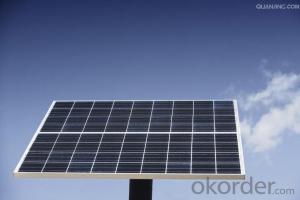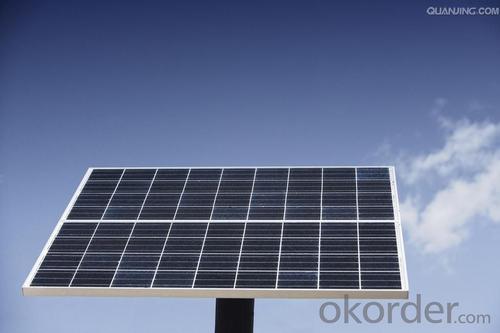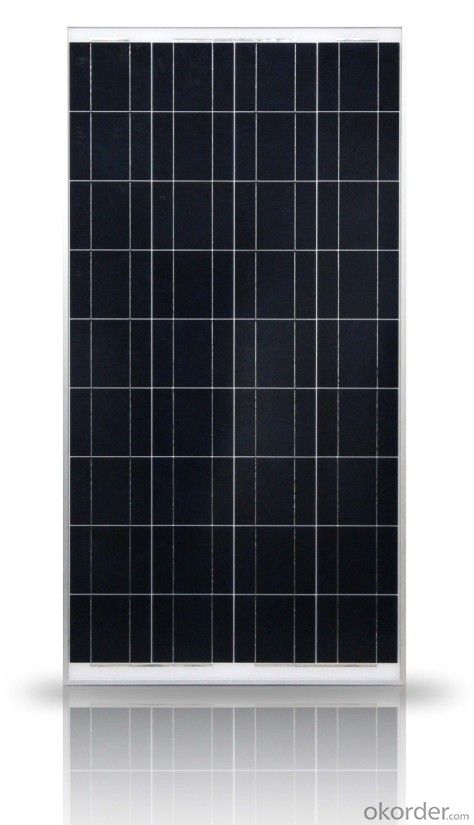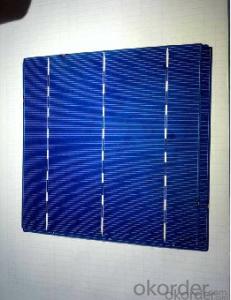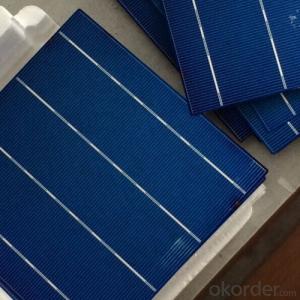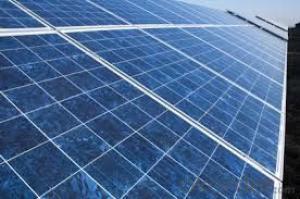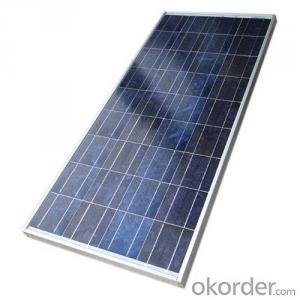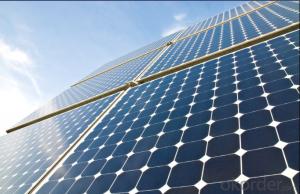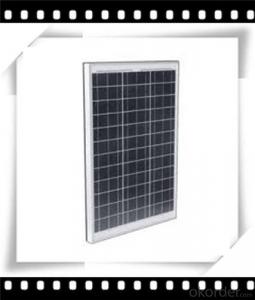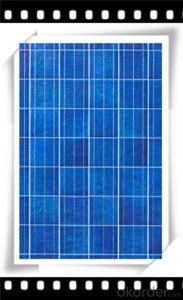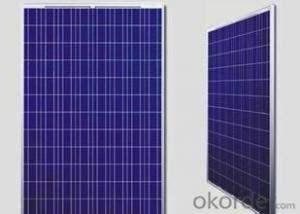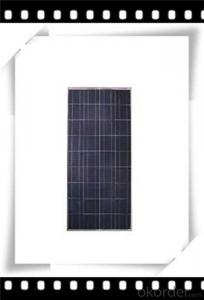Individual Solar Cells - High Efficiency Poly Solar Panel Hot Sale CNBM
- Loading Port:
- Qingdao
- Payment Terms:
- TT OR LC
- Min Order Qty:
- 10 set
- Supply Capability:
- 300000 set/month
OKorder Service Pledge
OKorder Financial Service
You Might Also Like
Polycrystalline Solar Modules
CNBM offers a range of small, medium and large polycrystalline solar modules, designed for a range of requirements.
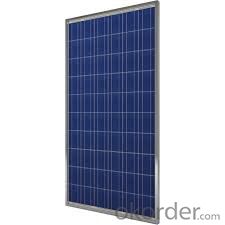
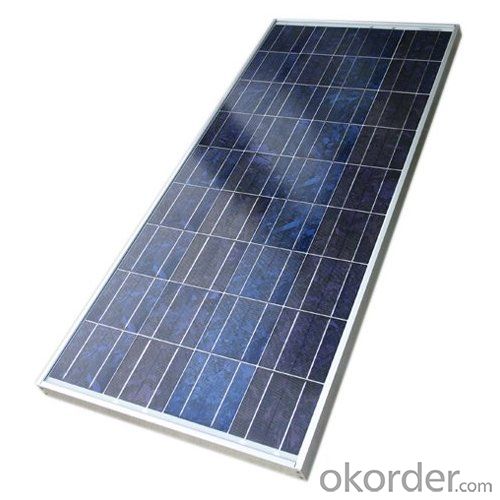
Specifications:
Tolerance | +/-3% |
Cell | Polycrystalline silicon solar cells (156 x 156mm) |
N0. of Cells | 60 (10 x 6) |
Dimension of Modules (mm) | 1650 x 990 x 40 |
Weight (kg) | 25.5 |
Limits:
Operating Temperature | -40~+85? |
Storage Temperature | -40~+85? |
Maximum System Voltage | 1000 VDC max. |
Hail Impact | Diameter of 28mm with impact speed |
Temperature and Coefficients:
NOCT | 48C+/-2? |
Voltage temperature coefficient (%/K) | -0.35 |
Current temperature coefficient (%/K) | 0.05 |
Power temperature coefficient (%/K) | -0.45 |
Characteristics:
Model: | SGM-200P | SGM-210P | SGM-220P |
Max-power voltage Vmp (V) | 29.2 | 29.4 | 29.41 |
Max-power current Imp (A) | 6.85 | 7.14 | 7.48 |
Open-circuit voltage Voc (V) | 36.5 | 36.69 | 36.9 |
Short-Circuit Current Isc (A) | 7.28 | 7.6 | 7.93 |
Max-power Pm(W) | 200 | 210 | 220 |
Model: | SGM-230P |
Max-power voltage Vmp (V) | 29.8 |
Max-power current Imp (A) | 7.72 |
Open-circuit voltage Voc (V) | 37.31 |
Short-Circuit Current Isc (A) | 8.19 |
Max-power Pm(W) | 230 |
STC: Irradiance 1000W/m2, module temperature 25?, AM-=1.5
Poly Crystalline Solar Panels Specifications Range
Maximum Power (Pm) | Dimension | Weight | Operating Voltage (Vmp) | Operating Current (Imp) | Open Circuit Voltage (Voc) | Short Circuit Current (Isc) |
0.45W | 140x80x10mm | 0.08kg | 3.3V | 150mA | 4.6V | 160mA |
1.0W | 162x140x10mm | 0.16kg | 7.5V | 150mA | 10.3V | 160mA |
4.5W | 269x251x23mm | 0.8kg | 16.5V | 0.27A | 20.5V | 0.3A |
10W | 420.1×268.9×22.6mm | 1.92kg | 17.5V | 0.58A | 20.5V | 0.6A |
20W | 425x502x50mm | 3.0kg | 16.8V | 1.19A | 21.0V | 1.29A |
30W | 593x502x22.6mm | 3.9kg | 16.8V | 1.78A | 21.0V | 1.94A |
40W | 655x537x50mm | 5.75kg | 17.3V | 2.31A | 22.1V | 2.54A |
50W | 839x537x50mm | 6.0kg | 17.5V | 2.9A | 21.8V | 3.17A |
65W | 1111x502x50mm | 7.2kg | 17.6V | 3.69A | 22.1V | 3.99A |
80W | 1204x537x50mm | 7.7kg | 17.6V | 4.55A | 22.1V | 4.8A |
- Q: How do solar cells perform in areas with high levels of air pollutants?
- Solar cells generally perform less efficiently in areas with high levels of air pollutants. Air pollutants, such as smog, dust, and particulate matter, can accumulate on the surface of solar panels, reducing their ability to absorb sunlight. This buildup of pollutants creates a barrier between the sun and the solar cells, decreasing their overall performance and energy production. Additionally, air pollutants can also block and scatter sunlight, further diminishing the amount of sunlight reaching the solar cells. Therefore, in areas with high levels of air pollutants, regular cleaning and maintenance of solar panels are necessary to ensure optimal performance.
- Q: How do solar cells impact air pollution?
- Solar cells have a significant positive impact on air pollution as they produce clean and renewable energy. By harnessing the power of the sun, solar cells reduce the need for fossil fuel combustion, which is a major source of air pollution. This means that the use of solar cells helps to decrease harmful emissions such as carbon dioxide, sulfur dioxide, and nitrogen oxides, leading to cleaner and healthier air.
- Q: Can solar cells be used for powering remote communication towers?
- Yes, solar cells can be used to power remote communication towers. Solar panels can be installed on the towers or nearby to capture sunlight and convert it into electricity. This renewable energy source is ideal for remote locations where access to traditional power grids may be limited or costly. Solar cells can provide a reliable and sustainable power supply for remote communication towers, enabling them to function efficiently.
- Q: What are the environmental impacts of solar cell production?
- The environmental impacts of solar cell production include the extraction and processing of raw materials, such as silicon, which can contribute to habitat destruction and water pollution. The manufacturing process itself requires energy and generates greenhouse gas emissions. Additionally, the disposal of old or damaged solar cells can pose challenges due to their composition and potential for toxic waste. However, when compared to the environmental impacts of fossil fuel-based energy production, solar cell production is generally considered to be much less harmful.
- Q: What is the impact of saltwater exposure on solar cell efficiency?
- Saltwater exposure can have a significant negative impact on solar cell efficiency. The saltwater can corrode the metal components of the solar cells, leading to a decrease in their performance and overall efficiency. Additionally, the saltwater can create a conductive pathway that can bypass the solar cells, resulting in a loss of electrical energy. Therefore, it is crucial to protect solar cells from saltwater exposure to maintain their efficiency and prolong their lifespan.
- Q: What is the lifespan of solar cells?
- The lifespan of solar cells can vary, but on average, they are designed to last for 25 to 30 years.
- Q: How are solar cells used in calculators?
- Solar cells are used in calculators to convert sunlight into electrical energy. This energy is then used to power the calculator, eliminating the need for batteries or other external power sources.
- Q: How do solar cells handle shading or obstructions?
- Solar cells are designed to handle shading or obstructions by employing bypass diodes. These diodes allow the current to bypass the shaded or obstructed areas, preventing them from affecting the overall performance of the solar cell.
- Q: What is the expected degradation rate of a solar cell?
- The expected degradation rate of a solar cell can vary depending on various factors such as the type of solar cell, the quality of materials used, the environmental conditions, and the maintenance practices. On average, however, most solar cells experience a degradation rate of around 0.5% to 1% per year. This means that the efficiency of the solar cell decreases by this percentage over time. Proper maintenance and regular cleaning can help mitigate degradation and extend the lifespan of a solar cell.
- Q: Are solar cells affected by shade or partial shading?
- Yes, solar cells are significantly affected by shade or partial shading. Even a small amount of shade on a solar cell or panel can greatly reduce its overall efficiency and power output. This is because shading disrupts the flow of sunlight, preventing certain areas of the cell from receiving direct sunlight and therefore generating less electricity. It is important to ensure that solar panels are installed in areas with minimal shade to maximize their performance.
Send your message to us
Individual Solar Cells - High Efficiency Poly Solar Panel Hot Sale CNBM
- Loading Port:
- Qingdao
- Payment Terms:
- TT OR LC
- Min Order Qty:
- 10 set
- Supply Capability:
- 300000 set/month
OKorder Service Pledge
OKorder Financial Service
Similar products
Hot products
Hot Searches
Related keywords
